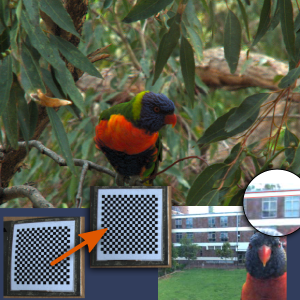Light Field Toolbox 0.4: Lineare Tiefen-, Fokus-, und Rauschunterdrückungs-Filter
 Wer der Entwicklung der Light Field Toolbox für Matlab folgt, hat vermutlich schon bemerkt dass der Autor ein Update mit neuen Features veröffentlicht hat: Light Field Toolbox v0.4 baut auf die Vorgängerversion auf und bietet zudem lineare Tiefen-/Fokusfilter und Filter zur Rauschunterdrückung in Lichtfeld-Bildern.
Wer der Entwicklung der Light Field Toolbox für Matlab folgt, hat vermutlich schon bemerkt dass der Autor ein Update mit neuen Features veröffentlicht hat: Light Field Toolbox v0.4 baut auf die Vorgängerversion auf und bietet zudem lineare Tiefen-/Fokusfilter und Filter zur Rauschunterdrückung in Lichtfeld-Bildern.
Für technische Informationen zu den Filtern und deren Anwendung verweist der Autor auf eine bevorstehende Publikation: D.G. Dansereau, O. Pizarro, and S. B. Williams, “Linear Volumetric Focus for Light Field Cameras,” to appear in ACM Transactions on Graphics (TOG), vol. 34, no. 2, 2015.
Wie immer können Interessierte direkt hier die aktuelle Version und das dazugehörige Light Field Sample Pack (Lichtfeld-Beispielbilderpaket) herunterladen, oder auf der Projektseite Näheres nachlesen:
 Light Field Toolbox v0.4 (977.1 KiB, 3,538 hits)
Light Field Toolbox v0.4 (977.1 KiB, 3,538 hits)
 Light Field Sample Pack for LightField Toolbox v0.3 and v0.4 (386.5 MiB, 3,270 hits)
Light Field Sample Pack for LightField Toolbox v0.3 and v0.4 (386.5 MiB, 3,270 hits)
Neue Funktionen in dieser Version:
LFBuild2DFreqFan – construct a 2D fan passband filter in the frequency domain
This file constructs a real-valued magnitude response in 2D, for which the passband is a fan.
LFBuild2DFreqLine – construct a 2D line passband filter in the frequency domain
This file constructs a real-valued magnitude response in 2D, for which the passband is a line. The cascade of two line filters, applied in s,u and in t,v, is identical to a 4D planar filter, e.g. that constructed by LFBuild4DFreqPlane.
LFBuild4DFreqDualFan – construct a 4D dual-fan passband filter in the frequency domain
This file constructs a real-valued magnitude response in 4D, for which the passband is a dual-fan, the intersection of 2 2D fans.
LFBuild4DFreqHypercone – construct a 4D hypercone passband filter in the frequency domain
This file constructs a real-valued magnitude response in 4D, for which the passband is a hypercone.
LFBuild4DFreqHyperfan – construct a 4D hyperfan passband filter in the frequency domain
This file constructs a real-valued magnitude response in 4D, for which the passband is a hyperfan. This is useful for selecting objects over a range of depths from a lightfield, i.e. volumetric
focus.
LFBuild4DFreqPlane – construct a 4D planar passband filter in the frequency domain
This file constructs a real-valued magnitude response in 4D, for which the passband is a plane. This is useful for selecting objects at a single depth from a lightfield, and is similar in effect to refocus using, for example, the shift sum filter LFFiltShiftSum.
LFDemoBasicFiltGantry – demonstrate basic filters on stanford-style gantry light fields
Generates and displays a set of filtered light field images as separate figures. Demonstrates the shift sum filter and 4D planar and 4D hyperfan linear filters.
LFDemoBasicFiltIllum – demonstrate basic filters on illum-captured imagery
Generates and displays a set of filtered light field images as separate figures. Demonstrates the shift sum filter and 4D planar and 4D hyperfan linear filters.
LFDemoBasicFiltLytroF01 – demonstrate basic filters on Lytro-F01-captured imagery
Generates and displays a set of filtered light field images as separate figures. Demonstrates the shift sum filter and 4D planar and 4D hyperfan linear filters.
LFDisp – Convenience function to display a 2D slice of a light field
The centermost image is taken in s and t. Also works with 3D arrays of images. If an output argument is included, no display is generated, but the extracted slice is returned instead.
LFFilt2DFFT – Apply a 2D frequency-domain filter to a 4D light field using the FFT
This filter works on 2D slices of the input light field, applying the 2D filter H to each in turn. It takes the FFT of each slice of the input light field, multiplies by the provided magnitude response H, then calls the inverse FFT.
LFFiltShiftSum – a spatial-domain depth-selective filter, with an effect similar to planar focus
This filter works by shifting all u,v slices of the light field to a common depth, then adding the slices together to yield a single 2D output. The effect is very similar to planar focus, and by controlling the amount of shift one may focus on different depths. If a weight channel is present in the light field it gets used during normalization.





Neueste Kommentare